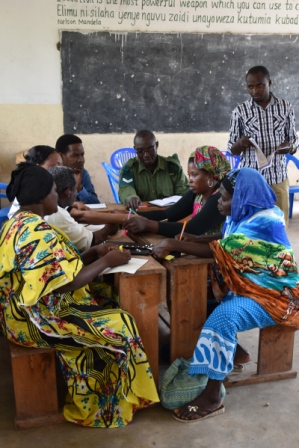Matipwili, Gongo, Mkange, Saadani, Buyuni, Mkwaja
Saadani National Park, Tanzania
Saadani National Park, established in 2005, is Tanzania’s only coastal national park protecting a unique mix of marine and land based flora and fauna. Its 1,100 km2 area was drawn together from existing protected areas, a private ranch and negotiated land transfers from the surrounding villages. Like much of rural Tanzania the villages surrounding the park depend almost entirely on subsistence fishing and agriculture with a paucity of infrastructure and public services.
Top environmental challenge faced by the community (currently or in the past 10 years):
The primary environmental challenge facing residents of the communities surrounding Saadani National Park is diminishing resource productivity. A number of factors create this challenge including: impacts of climate change especially impacting agriculture and fishing; rapid population growth; land use change including deforestation with the expansion of agriculture and population; the longstanding overharvest and almost complete collapse of the local fishery; and, the establishment of Saadani National Park, both the land acquisition process and the regulations implicit with national parks but which were largely unknown to local people.
How the environmental challenge has affected local livelihoods:
The overall impact of the diminishing resource productivity is increasing food insecurity. Rainfall has become increasingly unpredictable resulting in both drought and destruction of crops by flooding. Temperature increases have warmed the inshore waters causing fish species to seek cooler water temperatures in the offshore and beyond the reach of local fishers. Thus there is increasing pressure to diversify livelihoods from the traditional resource based economy but wage employment is scarce considering the shutdown of the rail line through the park area and the reduced production of salt from the area`s only industry due to pressure from the park. Without education local people also find it difficult to get employment with the park or the still small but growing tourism industry related to the park.
Community response to the challenge, through environmental stewardship (conservation) initiatives that improve environmental well-being and support sustainable livelihoods:
Responding to the environmental challenges faced by the communities can best be described as a work in progress. External inputs have been scarce and programs that were initiated in the past have failed. The most significant influence in the area is the park and relations with the surrounding communities has been difficult due to the widespread feelings of distrust resulting from years of conflict over park boundaries and the villagers unmet expectations regarding employment and other livelihood alternatives. Increasing attention on the part of park staff to the needs of the local communities is now creating greater cooperative engagement on the issues. The Kesho Trust contributed to this change through a project aimed at building more positive relationships between park staff and the surrounding villages by: reducing conflicts with park management through better understanding of the approaches and regulations related to conservation management; and, identifying alternative livelihood options that are compatible with conservation.
Extent to which governmental policy (at local, regional or national levels, as relevant) has supported, or been contrary to, the community's responses to the environmental challenge:
Government policy tends to be restrictive rather than supportive. The primary government influence in the area is Saadani National Park and because local government contributions to infrastructure and public services are extremely limited by lack of funding, the park is seen as a source for such development. However, national park policies currently exclude local community people from participating in management and they also limit opportunities for employment due to relatively high education requirements which people in the local villages rarely are able to meet.
Keywords: Ecosystem
Coastal, Marine
Keywords: Resources
Fish, Forest, Land, Water
Keywords: Big Issues
Climate change, Human-wellbeing, Land use, Resource use
Keywords: Solutions
Empowerment, Governance/Management, Public participation
Contributed by: Bruce K. Downie, Kesho Trust
The information provided and opinions expressed above are the responsibility of the contributor and do not necessarily reflect the views and analysis of the Community Conservation Research Network (CCRN), nor those of all members of the community described.
For any questions or comments on Communities in Action, please contact us
here.



